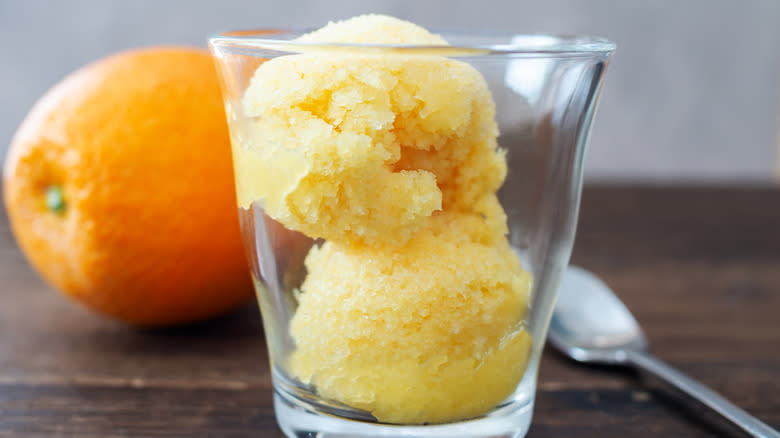Fresh Juice Is The Key Ingredient For Flavorful And Bright Orange Sorbet

Sorbet is all about the fruit. In comparison to silky sherbet or velvety ice cream, sorbet doesn't have a dairy base to hide behind. Even with the addition of sugar, a splash of alcohol, or additional mix-ins, the focus remains on fruit, whether it be puréed or juiced. That said, when it comes to making a knockout orange sorbet that's bursting with zest and punchy flavor, nothing gets the job done quite like freshly squeezed juice.
Fresher is almost always better. Since ripe and ready-to-enjoy fruits have more volatile compounds, this increases aromatics in fruits like oranges. With fragrance at its peak, this actually works to enhance our perception of flavor, which is why we consider fresh juices to taste superior and be of higher quality. But that's not the only advantage of using freshly squeezed juice to make sorbet.
Just-squeezed juice has a more varied and vibrant flavor profile when compared to processed juices made from concentrate. Unlike store-bought versions that are one-dimensional and generically sweet, fresh juice's saccharine quality tastes light and integral and pairs well with both the crisp acidity and delicate notes of flavor that hint at the ripeness of their source. What's more, fresh orange juice also reigns supreme in terms of color. While juices from concentrate can give sorbet a bold and brassy (read: artificial-looking) hue, fresh juice imparts a more subtle and natural shade of orange.
Read more: 11 Drinks That Are Red Flags For Bartenders
Pick Oranges Wisely, And Juice Them Accordingly

For the freshest orange juice, start with top-tier produce. Oranges should have vivid colors with thick and bruise-free rinds. Additionally, citrus should be firm and heavy for their size, as this will indicate a juicier interior. Of course, opting for varieties known for their juiciness, such as sweet Cara Cara oranges, balanced Valencias, or red-tinged Taroccos, won't hurt. You could even mix and match types for added depth. Lastly, let your nose be your guide — the sweetest and most succulent oranges will also be the most aromatic.
Knowing how to extract the most juice is important regardless of which oranges you select. Due to the complex cellular structure of citrus, warmer fruits tend to yield more juice, which is why heating oranges briefly in the microwave or a bowl of warm water is recommended. Likewise, rolling citrus can also help as pressure works to crush cell walls and release juices more easily. Then, pop segments into a juicer or roll up your sleeves and get to squeezing!
Once the bag has been juiced, you can finally start making sorbet. Although recipes made entirely with freshly squeezed juice will have a brighter profile, sometimes you lack the luxury of abundant fresh produce. In this case, adding fresh juice sorbets made from mainly concentrated juices can help to perk up the flavor. Put this tip to the test, and taste the difference for yourself!
Read the original article on Tasting Table.

